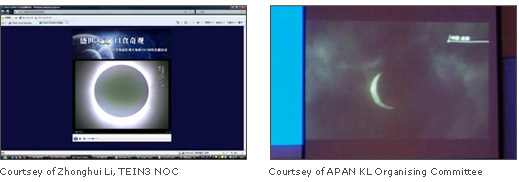Thursday, 23 July 2009 | Kuala Lumpur, Malaysia and Cambridge, UK:
On 22 July parts of Asia saw the Earth’s longest total solar eclipse of the 21st century. It was visible from a narrow corridor traversing India, Nepal, Bangladesh, Bhutan and China. After leaving mainland Asia, the path crossed Japan’s Ryukyu Islands and ultimately curved southeast through the Pacific Ocean.
Most of the best viewing opportunities were in China and Japan where millions of people were flocking across the eclipse path to witness this special event. Thousands of miles away, in an air-conditioned conference room at the Berjaya Times Square Hotel in Kuala Lumpur, delegates attending the 28th Asia-Pacific Advanced Networking (APAN) meeting were equally able to be part of this spectacle in real time: thanks to live broadcast streaming from China and Japan over the respective national research and education networks and the regional TEIN3 backbone, attendees witnessed the gradual blotting out of the sun directly on their laptop and main presentation screen, living one of those special moments in a lifetime. They also had in-depth presentations and discussion of the technologies used to capture and broadcast this major event.
Kamal Hisham Kamaruddin, Network Operation Manager of the Malaysian research and education network MYREN, which hosted the APAN meeting commented: “MYREN is very proud to have contributed to allowing the delegates to be part of this extraordinary event. It just shows that high-speed networking makes it possible to study and become part of history remotely”.
Special credit goes to Dr. Jilong Wang, the director of TEIN3 NOC and CNGI-CERNET2 NOC, for leading the design, implementation and demonstration of the live streaming of the solar eclipse from CNGI-6IX to the APAN meeting in KL over the TEIN3 backbone.
Details of the routing are as follows:
IPv4 Streaming from Japan
Route : QGPOP(Kyushu Univ.) -> SINET -> TEIN3 -> MYREN
Credited organisations:
QGPOP (Kyushu Gigapop Project)
Kyushu UniversityNational Astronomical Observatory of Japan Keio University
Ultra-Realistic Communications Forum
National Institute of Information and Communications Technology

